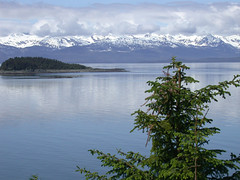 A glacier at Tracy Arm Fjord near Juneau is shown above
A glacier at Tracy Arm Fjord near Juneau is shown aboveBy Scott Beveridge
JUNEAU, Alaska – When the tide goes out, the table is set,
according to an old Alaskan saying.
It's a reference to the dramatic high and low tides each day that wash ashore seafood, offering residents and black bear fresh catch for their diets.
After the water level drops, hard-shell fish litter the banks of the Inside Passage in the Juneau area by the millions, crunching underfoot if you don’t watch where you’re walking along the beach.
The feeding grounds at the water's edge make sightseeing cruises a thrilling adventure, allowing passengers a glimpse of the abundant wildlife at work on its marine diet. By boat, tourists can watch humpback whales, mountain goats, porpoises and seals from most angles. The snowcapped mountains that make up Tongass rain forest jut 3,500 feet above sea level, and their deep pine forests provide pristine nesting grounds for bald eagles.
The wildlife and breathtaking scenery are making the Southeastern Alaskan panhandle an increasingly popular cruise ship destination. As many as five giant floating hotels can be seen moored at the harbor in Juneau, Alaska's capital since 1906, at any given time during the tourist season.
With the number of cruise ship passengers to this city of about 30,700 residents approaching one million a year, local residents have begun to complain about noise and pollution. The Mendenhall Glacier, the most-visited tourism site, now receives nearly 250,000 visitors each year to its visitor center, built in 1962 to accommodate just 25,000 people a year, according to the National Park Service.
This is a city that can only be reached by boat or air. Residents must order most of their supplies from catalogs or via the Internet and wait longer periods of time for them to arrive. The dress code is casual.
“We have no factories,” a shopkeeper noted at one of the many gift shops that mostly sell tokens made in China. Totem poles and other local crafts made by natives, meanwhile, are offered for expensive prices.
The Tlingit Indians settled in the region's fishing grounds roughly 4,000 years ago. Boatloads of prospectors, including Joseph Juneau, made their way here after 1880 in search of gold in Gastineau Channel. Today, however, tourism is the largest industry.
Many who travel here by cruise ship take helicopters to nearby ice fields that separate the Alaskan peninsula from Canada. There they take a short hike with a pilot to sample glacier water before returning to their cabins.
These visitors have to skip one of the region's most dramatic sights, Tracy Arm Fjord, reachable only by smaller boats that can navigate over the sand bar at its entrance.
The sea quickly changes color to a milky green-blue because of silt and ice floe from the fast-melting twin Sawyer Glaciers, according to the guide working for Auk Nu Tours.
The Smithsonian calls Tracy Arm one of the world's most dramatic fjords, formed by glaciers 2,000 feet thick. Bald eagles hover where sections of the glacier are about to calve, waiting for icebergs to crash into the sea and stir fish for feeding to the water's surface.
 These tours last about eight hours, and they include talks by naturalists, who point out black bear munching on grass along cliffs, or harbor seals resting on floating icebergs.
These tours last about eight hours, and they include talks by naturalists, who point out black bear munching on grass along cliffs, or harbor seals resting on floating icebergs.Sea kayaking, mountain climbing, hunting and fishing await visitors who are in Juneau for more than just a few hours.
Some pass the time by taking the nearly 40-mile drive up and down the main road called Egan Highway, where the south end provides this incredible view:

The road signs are shot up for target practice, possibly by those who grow bored from the long winter darkness or any of the nearly 222 rainy days a year. Tourist season runs between May and September, with the average temperature hovering in the 60s during the summer.
Longer hikes around Mendenhall Glacier also are available with forestry experts, who discuss the return of life to barren land after it is exposed by the retreating ice fields.
“There are no snakes here. We just have big animals,” a guide at the glacier noted, as a porcupine scurried past a group of tourists.
(Portions of this were reprinted with permission of the Observer-Reporter.)

No comments:
Post a Comment